Call Us: 855.266.5676 | 954.684.0218
Email Us: info@curtisstokes.net 
Call Us: 855.266.5676 | 954.684.0218
Email Us: info@curtisstokes.net 
The Great Loop cruise is many different things to different people. It is unquestionably a mix of opportunity and challenge. Social, travel and sightseeing opportunities abound, and are very satisfying and fulfilling. Challenges come in the form of piloting and navigation tasks, weather and facility delays and equipment breakdowns in scales ranging from “trivial” to “urgent emergency.” Ambiguity will be your constant traveling companion. Uncertainty and the unexpected will challenge your self-confidence, patience, self-sufficiency, and personal sense of independence. The Great Loop cruise is a personal exploration and growth opportunity. It is also – at a minimum – a trip of 5500 StM by water; sometimes calm water, sometimes lumpy water. During the trip, both captain and crew will get tired and need rest and relaxation time.
This monograph is divided into three sections:
I hope it is useful to those contemplating this wonderful, exciting and rewarding long cruise!
“Official Government Legal Stuff:“ If you plan travel into Canada and/or into the Bahamas, do your homework on the formalities.
Hull, Boat and Personal Liability Insurance: In the US (I don’t know how tis works in Canada) the “normal” way one contracts for personal liability protection is through a homeowner’s or renter’s policy. Personal liability coverage is a standard feature of Homeowner’s policies and Renter’s policies, but is not a standard feature with a boat insurance policy. All boat policies will cover liability that occurs in association with, and incidental to, the operation of the boat, but boat liability insurance does not cover events that occur away from, and which do not involve, the boat. So, for example, if you’re off shopping at Walmart, and you manage to trip an old lady in a walker, your boat insurance may not provide the personal liability coverage you need to protect you. Especially if you are a full-time cruiser without a land residence, be sure to investigate personal liability coverage when you contract for boat insurance. The MTOA has an excellent Member Benefit boat insurance program through four very high quality providers. One of the four now provides personal liability coverage as part of their boat insurance policy offering, so is a good match for full-time live-aboards without a land-based residential liability policy.
When departing on the Great Loop cruise, check with your boat insurance broker/underwriter about taking your boat across international borders. Some boat underwriters require riders to enter Canada, others include coverage if the “Great Loop” is included in the policy cruising limits on the declarations page of the policy. Always do your own due diligence!
Towing Insurance:
Understand “towing” vs “salvage;” consider needs for independent towing insurance through Towboat US or SeaTow. Both TowBoat US and SeaTow provide a range of towing options at reasonable annual premium. In some parts of the US, one or the other of these companies will have a larger local presence than the other. Sanctuary has utilized Towboat US insurance twice in 12 years. Once to actually tow us, and once to bring us parts in lieu of towing. We recommend this coverage. Note that both TowBoat US and SeaTow operate only in the US. We are not aware of similar operations in Canada or the Bahamas.
Boat Operation Skills:
Some may find this list intimidating. We understand that. This list is not intended to discourage anyone from cruising, either regionally or for the Great Loop. The loop is a very safe cruise. It is, after all, just a series of day trips strung together in mostly inland waters. There are no pirates, but the loop will take you to places that are remote from towns and cities, and will take you to places where you are totally unfamiliar with your surroundings. Along the loop, it’s unlikely you will ever be out of radio range of other loopers. It’s even more unlikely you’ll be out of range of the various national Coast Guard authorities. Throughout North America, safe channels are well marked and navigation charts are accurate and available.
All of this said, however, boating skills are needed at the helm or every boat on the water. There is “big water” out there. There are congested commercial ports and inconsiderate pleasure craft operators. It’s not always like driving big-city rush hour traffic, but there are times when that’s just what it’s like. No matter how carefully and thoroughly one plans on a day-to-day basis, there will be unforecast and unexpected foul weather, thunder storms will blow through in the middle of the night, there will be unexpected high and low tides and swift cross-currents, there will be equipment failures, and there will be many “surprises and adversities.”
We strongly recommend that loopers have at least one season of experience handling their loop boat before departure. There will still be surprises along the way, but basic boat handling, control and docking are ALWAYS essential skills for every captain.
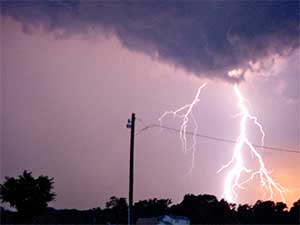
Boat Maintenance Skills: All boat owners should be able to perform certain basic boat and engine maintenance tasks. These tasks are fairly simple, and there will almost certainly be a time when a situation arises, presents the need, but a mechanic will not be available. You will have to do at least some of these tasks without help. Things like:
Think of this like you thought about your kids when they learned to drive. You may not expect them to rotate their tires, but you did teach them to change a flat tire. Same principle here, and for the same reasons.
Automobile Insurance: Always do your own due diligence! Everyone’s personal situation is different in this critical area. In many places, cruisers will have the opportunity to rent a car, borrow a car owned by another individual, or use a marina courtesy car. All of these choices carry liability and collision risks. Boaters who own vehicles at home and maintain their automobile insurance policies will have different issues than the who do not. Those with insurance coverage must understand what the policy does and does not cover.
Insurance called “Named Non-Owner (NNO)” coverage is an option for those who have sold their cars to go cruising. NNO (Named Non Owner) coverage is liability coverage. In an accident while driving a vehicle owned by someone else, the vehicle owner’s liability coverage applies up to the limits of the owner’s policy. The NNO policy will kick in after the owner’s policy limits are exhausted, up to the limits of the NNO policy. If there is also an umbrella policy, that umbrella will kick in when the NNO policy limits are reached, provided the NNO meets the requirements of the umbrella. My understanding is, there is no comprehensive coverage offered for non-owned vehicles.
Health and Medical Insurance: Always do your own due diligence! Everyone’s personal situation is different in this critical area. First of all, assume that on a trip of this length, something may happen: a toothache, a cut that becomes infected, a finger caught in a line, a fall. Not everything will happen to everyone, and some my get by without incident, but plan ahead for the contingency. Canada and the Bahamas have flavors of socialized medicine which will cover many emergency costs. Medical facilities in the Bahamas are not generally at the same standard of care found in the US and Canada. Many Bahamian islands have only clinics, and many of them are not staffed all day or every day. Many do not have X-ray, CT or MRI capability. US Medicare recipients should be aware that Medicare does not provide coverage outside the US.
Emergency Evacuation Insurance: Diver’s Action Network and other companies provide emergency evacuation insurance that will bring seriously injured or ill patients back to the US mainland for treatment. DAN provides evacuation protection; it is not medical coverage. DAN evacuation insurance is reasonable. Consider your health and the possibility of this need in the context of your personal situation.
Prescription Medications and Medical Devices: Always do your own due diligence! My Admiral and I take over-the-counter vitamins and aspirin, and prescription statin anti-lipid drugs. I take prescription eye drops, and she takes several cardiac medications. Well in advance of your planned departure, order a 3-month supply of all prescription medications. With the proper documentation, customs and immigration officers will clear them. Without documentation, check-in delays are possible, if not likely. It can be a problem to ship some medications across international borders, so medications that you absolutely cannot be without must be transported with you.
In the past several years, we have dealt with several different mail-order pharmacies. They are not very good at supporting travelers. No, it’s worse than that; they are a superb pain in the posterior. We know that they can accommodate travelers, so stay calm, but be persistent. Order early, and order only when you’re going to be in one place for long enough to wait them out. Different medications will come from different warehouses in different parts of the country. Be sure to update your delivery address a couple of days before you actually place the medication order.
Expect surprises. We have gotten to the point that we call the pharmacy company a day or two ahead of placing the order just to update our shipping address. That allows time for the updated delivery address to propagate across the pharmacy company’s server farm. We have had parts of our medication orders go to several different, random delivery addresses. The pharmacy companies will always blame that on you. They will want to use up one of your refills and will threaten to charge you full price for a re-do of the order. We can scramble through all that, but it’s time-consuming and annoying. If you change your permanent address before you place the order, there is a better chance they’ll get fulfillment delivery right. But, it’s on you to manage the process and your pharmacy company.
When cruising, be sure to have documentation for any injectable medications and injection supplies that you transport. What particularly comes to mind is diabetes medications and needles and epinephrine injectors for anaphylactic allergic reactions. Sanctuary’s Admiral uses a medical device called a “TENS unit.” It’s electrical, and runs on batteries. Carry spare batteries, and if you need/use rechargeable batteries, carry a spare charger. Get a copy of the prescription from the doctor to keep in your onboard file.
Talk with your doctor before departure about having a 10-day supply of antibiotics and pain killers aboard for use in emergent situations. If you’re cruising in some remote place, it may be a day or two or three before you can get to see a nurse, let alone a doctor. Starting an antibiotic right away may be/can be the right thing to do. We were traveling in the salt marshes of the US southeast when the Admiral came down with an abscessed tooth. Having a pain killer at hand definitely made us both more comfortable until we could locate a dentist. I nicked a finger, and within 18 hours it was three times normal size and very painful. I caught the wheel of a shopping cart at Walmart. By the next morning, my ankle was several time normal size. Things happen. Having a supply of Cephalexin was a really wise exercise in planning ahead, but it does not replace seeing a doctor as soon as you can.
Emergency Care: many pharmacies offer emergent care services intended to manage relatively minor health incidents. They also administer flu, pneumonia, tetanus and shingles shots (shingles with a prescription, of course). Walgreens and CVS are two national pharmacy chains we have used successfully. These facilities are typically staffed by a Nurse Practitioner. The ARNP will be able to prescribe antibiotics, and handle simple conditions like skin rashes, bruises, splinters, cuts with simple stitches, burns, sprains, and similar types of injuries. Depending on state law, an ARNP may not be able to prescribe opiate pain medications. For initial assessment of an emerging situation, these facilities are very helpful, if available.
Free-standing emergency care facilities are also available in many areas. These usually have on-site staff physicians. Obviously, they can handle a wider range of health problems, including x-rays, simple blood and urine labs, and EKGs.
ANYONE HAVING CHEST PAIN OR DIFFICULTY BREATHING SHOULD IMMEDIATELY MAKE A “MAYDAY” CALL. LIKEWISE, MENTAL CONFUSION, SLURRING OF WORDS OR DROOPING OF FACIAL EXPRESSION, HEAD INJURIES WITH OR WITHOUT CONFUSION AND SERIOUS FALLS REQUIRE IMMEDIATE, URGENT EVALUATION AND CARE. Plan and drill ahead of time for the possibility of a “m’aides” call. Know what you will need to be able to tell the USCG and rescue personnel about your location and the nature of your emergency. Emergencies don’t care about the weather or seastate, so consider how you would handle the boat while caring for your spouse’s chest pain BEFORE an emergency happens.
e-Banking, Bill Paying: Go “paperless.” Have all income directly deposited. Every payer can arrange that these days. Purchase everything via credit cards, get the loyalty program points, and pay the credit card bill online. Get at least one credit card that doesn’t charge fees for international transactions. Most banks, credit unions and investment houses can arrange to direct-pay repeating monthly bills you might have, like a boat loan, mortgage or an insurance premium. We probably write fewer than 6 checks a year anymore. We love that!
Credit/ATM Cards: Plan to carry credit cards issued by multiple banks. Before departing, and every two or three months, call your credit card companies and let them know your upcoming planned travel plans. Call credit card issuers particularly when you’ll be crossing international boundaries. No matter what you do, from-time-to-time one of your banks will shut down your card at some random and unpredictable moment. We had that happen to us at Ste. Jean sur Richelieu. We had gone to the local Bank du Canada branch to get $200 CDN in Canadian currency. When the credit card processing system came up with an “unknown error,” we were told that some US Credit Cards couldn’t be “cleared” from Canadian banks. We don’t have any idea if that’s correct or not, but our transaction did not clear. The effort apparently made our US Visa bank nervous, and they forthwith put a stop on the card. This has also happened to us in the US subsequent to crossing a state line, and because the profile of normal purchases appeared “suspicious.” In any case, having a different kind of card from a different bank can get you through these events.
US Mail: There are several ways people choose to handle their US mail (snail mail). Sometimes, adult children or close friends can be used to collect and forward mail. In some cases, mail forwarding from the post office can work. When we moved aboard, we opened an account with St. Brendan’s Isle in Green Cove Springs, FL (SBImailservice.com). This has worked very well for us. St. Brendan’s Isle collects our mail, and we have it forwarded to us when we want it. The service qualifies and a “physical address,” so it meets the requirements of the US Patriot Act and qualifies as a legal address for Florida residency, voter registration, bank and investment accounts, driver licenses and insurance. Having “gone paperless,” we have minimal US mail anymore. Most of our snail mail comes from medical providers, which as a class are uniquely stupid about paperless e-billing. So, I never mind much making them wait. St. Brendan’s Isle has a service where they will scan your mail and send a daily email about what’s there. I recognize the envelops we do get, and if I need them to, they will open the envelop and scan the contents. These services satisfy all of our mail needs.
Golden Age Passport: US citizens 62 years of age or older are eligible for this US National Park Service program. Visit any National Park Service location and purchase a “Golden Age Passport” for a one-time fee of $10.00. In every National Park Service location, the Golden Age Passport will get you and your entire party reduced prices on admission, and sometimes on separately priced for-fee attractions. In many places, admission fees will be waived entirely. This card is also accepted at some US government facilities operated by the Army Corps of Engineers, Fish and Wildlife Service, Forest Service and the Tennessee Valley Authority.
Cruising Guides: Paper causing guides are available, but are seen by some as becoming obsolete. For all areas that Great Loop Cruisers will encounter, there are excellent guides available. Several online resources are available, but have highly variable utility. One Internet resource of moderate-to-high value is www.ActiveCaptain.com. Referred to as “crowd sourced” data, the data at ActiveCaptain.com is submitted by other cruisers. However, the data is subject to aging, so cruisers must verify the data posted there. Some guides are available as eBook epub or pdf files for electronic media and distribution. In electronic form, they are less expensive and require no physical space aboard. Usability is mixed, but improves every year.
Family and Non-family Guests Aboard: We have enjoyed traveling with grand children – of which we have 9 – aboard. Some young ‘uns entertain themselves better than others. We established a family rule that grandkids had to be at least 10 years old to cruise with us without their folks. ‘Nuf said.
In general, prepare visitors (and parents of young visitors) for the cruising experience they will have well before they come to the boat. Explain what “sea state” means. Explain what “lumpy” means. Be sure to tell visitor’s to bring soft-sided, collapsible baggage, such as duffle bags. There is precious little space aboard any boat for storing air in empty suitcases. Let them know that bathing suits work for underwear. Let them know that showers will be limited and fresh water is always a precious commodity to always be conserved! Make sure they understand about marine toilets and holding tanks. Put up a sign in the head: “Nothing shall enter here that has not been eaten first!” Make sure you – as the captain and the host – understand any food allergies or sea sickness concerns. Your visitors will not be as used to traveling by boat as the regular crew is. If you are taking responsibility for kids, make sure you understand any medications they need to take and whatever condition(s) those medications are intended to treat! For minors in the absence of their parents, have written and notarized parental permission to seek and request medical treatment if that should become necessary. As we Boy Scouts are fond of saying: “Be Prepared!“ Prepare your guests! Being prepared may save disappointment, discomfort and distress.
Weather: “To Go Or Not To Go:” Because the Great Loop cruise spans significant geography in eastern North America, weather conditions encountered by Great Loop cruisers will range over time from “delightful” to “severe.” Annual El Niño and La Niña conditions in the eastern tropical Pacific Ocean, and the Madden-Jullian oscillation in the Western Pacific and Indian Oceans, can lead to significant year-to-year variations in overall North American weather patters. Regional conditions in the southern US are different than in the northern US and Canada. Year-to-year variations are a fact of life. There are dry years and wet years.
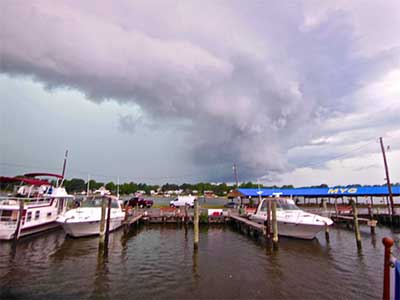
Right: Summer T’storm Outflow Boundary produced 50-plus mph gusting winds for 40 minutes. Could not see the shoreline, barely could see the blue-roofed MYC Pavilion. Very exciting!
In general, I discourage the all-to-common notion that a fast boat can “run away from” – or, “outrun” – developing thunderstorms. The air masses that produce thunderstorms can be hundreds of miles across. Very large air masses can become unstable (cross the “wet lapse rate”) in minutes, and build across wide areas very quickly. We have had severe weather blow up for 30 to 50 miles all around us in a matter of 15 – 30 minutes. Being exposed in a boat on the water is not part of our definition of “havin’ fun.” We suggest prudent avoidance is much better than managing an unpleasant – or dangerous – heavy weather encounter.
We suggest that each individual cruiser establish – in advance – a written criteria for the conditions that are acceptable for their routine daily departures from safe harbor. One size does not fit all, and no single cruiteria fits all cruisers. Different boat designs ride rough seas quite differently from one another. Different individuals on boats of the same make and model may have different attitudes and sensitivities about what constitutes “acceptable” travel conditions to them. Boats with active stabilizers may handle rough seas better than boats without stabilizers. Individualized vessel departure criteria must address the needs of the captain and crew, pets, any guests (children) and the vessel itself. The departure criteria must ensure the safety, and consider the comfort, of all aboard. Boat’s are generally tougher than people. We find little enjoyment in being beaten up on the water. Seasick or terrified guests are undesirable. A happy crew and a happy marriage depend on getting this criteria right for your crew and your boat.
Finally, the prudent captain will review the weather forecast for the daily cruise area against his or her departure criteria. A beautiful early morning can deteriorate into a lousy day. Sanctuary’s departure criteria follows:
| Acceptable: | Bright sun to light rain; visibility > 3 StM; Seas < 2 ft from any quarter; winds < 15 kts. |
| Marginal: | Periods of rain, no or “isolated” t’storms; visibility > 1 < 3 StM; seas 2-4 ft if following, 2-3 ft if ahead, abeam or abaft of abeam; winds 20-25 kts; these conditions stable or with an improving forecast. |
| Unacceptable: | T’storms; strong squalls; visibility 25 ks; deteriorating forecast. |
| Additional Considerations: | Travel on protected inland river/ICW vs. open water; distance from “safe harbor;” if offshore, period and direction of ocean swells; air temps; hours-of-daylight; summer wx patterns; availability of traveling companion (“Buddy Boat”), availability of Tow Boat if needed. |
Some useful resources for tracking local weather and weather forecasts include:
Boat equipment: I will not attempt to create a rigorous list of equipment here. There are many sources for the common and ordinary stuff. I will limit my remarks to some items that I think don’t get enough visibility, context and/or consideration.
We recommend everyone carry a conventional #12AWG, 100′ utility extension cord aboard. 125V, 50A shore power fittings are very uncommon and we never encountered one during our Great Loop cruise in 2007. We did encounter residential 240V, 50A outlets (like those used on residential electric range/ovens and kilns) in various places along the Erie Canal system and some pubic walls. Because we had an adapter to access those outlets, we had shore power when others did not.
We use over-the-air TV for local weather forecasts. We subscribe to a satellite TV account for general TV watching, which works well for us. Our satellite tracking antenna is regarded as a “low end” solution. There are several fully automatic solutions available, at greater costs, but it’s unclear if they have an greater reliability. Our system works well, requires no programming, and meets our needs for simplicity and usability. The internal fluxgate compass is affected by nearby metals, such as ladders and railings at walls or structural metals within bulkheads. These metals affect antenna aiming, but have never caused us to not have TV if we wanted it.
Decision: Selecting the “RIGHT” boat: this is largely a personal-preference exercise. Make sure to consider boat use preferences when considering boat features. Anchoring out requires enough battery storage capacity to carry the boat’s refrigeration and electrical demands at least over night. Cooking aboard requires some sort of fuel for the cook top.
Decision: Cruisers with ongoing personal and/or business obligations: cruisers with ongoing business interests or family obligations at home must – it goes without saying – plan ahead. Most of the Great Loop cruise offers reasonable proximity to airports. Some locations are particularly easy, like Albany and Rochester, NY, Traverse City, MI, Wilmington, NC, Norfolk, VA, Washington, DC and Baltimore, MD. In these locations, safe and well protected marinas are located within easy local travel distance to local airports. Plan these locations as stopping places from which to “go home.”
If you plan to run a business while cruising the Great Loop, expect that to be easier in some places than others. Internet and cellular telephone system access remains variable along the loop route. Cellular calling plans are available in Canada. Cellular data plan options continue to improve, but remain a challenge for non-Canadian citizens. Cell phone and data plans are both challenges in the Bahamas. Access to post offices and UPS Stores is possible in many, but not in all, places in the Bahamas. Inconvenience and increased cost will be a constant companion, and delays in material delivery will be common.
Decision: Complete the Great Loop cruise in one year or across multiple years: This can be a complicated decision, but if you contemplate storing the boat “up north” over the winter, you must decide on a location and secure a storage contract. Do so early. Indoor heated storage is best. “Heated” usually means heated to a temperature slightly above freezing; 45ºF of 50ºF.
Decision: Travel Clockwise or Anti-clockwise: Because of the generally north-to-south flow of the great inland rivers, and the swift river currents that are probable, most boats travel anti-clockwise. That is, northbound on the US east coast, westbound from New York through the great lakes (either in the US or through Canada), southbound from Mackinac, MI, to Mobile Bay, AL, and eastbound from Mobile Bay to South Florida. That strategy places Loopers in Canada in the summer and in the US Great River watershed in the fall of the year. This is the period when ordinary severe storm systems and river levels are at seasonal lows in severity and frequency. It is also a strategy to avoid hurricane systems on the US east coast.
It is, however, possible to travel clockwise. Clockwise travel requires careful planning. The spring season in the Great Rivers watershed is when storm system are most severe and most frequent. This often brings very high or flood stage water levels, and very swift river currents. High water and swift currents bring the risk of river closures, dangerous flotsam and debris, and long travel delays. From Mobile Bay, AL, to Chicago, IL, those currents will also be largely against the direction of travel of northbound boats, so those contemplating this option must carefully consider daily travel time desires, daily travel distance desires and fuel use implications. Plan carefully.
Decision: Tolerance for daily travel distance: The Great Loop cruise is a personal exploration and growth opportunity. It is also a minimum of 5500 StM. During the trip, both captain and crew will get tired and need rest and relaxation time. Agree among yourselves what your general preferences are for daily travel. Then, truly unusual circumstances or emergencies excepted, honor your agreements. Do not get so tired of traveling that your enjoyment of the journey is impaired. DO NOT HAVE A SCHEDULE. Having a schedule violates the Prime Directive; a schedule will drive you to take the wrong actions at the wrong times.
Decision: Route Alternatives and Side Trips:
The traditional route of the Great Loop takes the cruiser north on the US East Coast, and Hudson River, West via the Erie Canal, Canadian Rideau Canal and Trent-Severn Waterway, Georgian Bay and the North Channel, South via Lake Michigan, the Great Rivers and Ten-Tom Waterway, and East from Mobile, Alabama, to Florida. Route alternatives include:
There are many delightful side-trip options available as one travels the Great Loop. Some include:
The choices are all wonderful experiences, but planning is necessary. Time management is your constant challenge. Do not over schedule, as it will lead to frustration and exhaustion. Constantly reassess your stamina and the stamina of your crew.
Decision: Float Plan Itinerary: Planning for the Great Loop cruise depends in large measure upon knowing the type of boat that will be used as the traveling platform. Once boat type is known, we suggest consulting with owners of similar boats; and especially, those who have already completed the loop cruise. From other cruisers, get ideas on comfortable cruising speeds, daily travel distances and boat handling limits. Then, work out a “template” for your loop cruise that you think will meet your personal desires and needs. Understand that this template will change frequently with emerging and changing family needs, mechanical delays, unexpected facility closures, and weather delays. This template is not a “schedule;” it is only an outline of a plan; a list of possibilities.
We used our initial template to verify for ourselves that we could nominally complete the cruise before the cold months of the late fall and early winter overtook us. We wanted to be in SW Florida for Thanksgiving, but in any event, no later than early December. Once we saw that we could accomplish that goal and still enjoy leisurely travel along the way, we were significantly more confident about our plans. One decision we made was to eliminate a cruise up the Cumberland River from our itinerary. We will save that for future travels.
One factor that increased our comfort level was that we did not plan to spend time on our home waters (the Chesapeake Bay) on this cruise. That allowed us to allocate time to cruising the Georgian Bay and North Channel.
Decision: Traveling with pets: Pets are a significant consideration for long range cruisers. Cats are generally, but not always, easier than dogs. Small dogs are generally, but not always, easier than large dogs. Multiple dogs are a lot of work. Animals get seasick. Animals also get sick sick, just as people do. There are many places where finding a veterinarian on a timely basis will be challenging.
There are many places on the loop where landing a pet for toileting will be impossible. There is no actual “land” in a mangrove swamp. Furthermore, in parts of Florida and the southern US East Coast, there are swamp creatures that represent real danger to people and pets. There will be many, many places where getting a pet ashore will be severely difficult. Your boat and dinghy configuration will have an enormous impact in this recurring task. Traveling with a pet will almost certainly increase the out-of-pocket cost of the cruise, because it’s likely you will forgo anchorages in order to go into a marina where you can take Rover ashore for toileting.
Finally, plan ahead for pet medications just as you would for your own.
Because we live aboard year ’round, we did not have a realistic option of storing Sanctuary “up north” over the winter. We planned our Great Loop Cruise to enable us to complete the circuit in a single year. We started in Punta Gorda, Florida, on March 30, 2007, and crossed our wake in Punta Gorda, FL, on November 16, 2007.
Any poll of “must stops” for the Great Loop Cruise would result in as many opinions as there are respondents. This topic is highly dependent on personal tastes and personal preferences. We like a relaxed pace, informal atmosphere and dress, small communities, science museum’s and Revolutionary War/Civil War history. We aren’t symphony, theater, or “city people.” Our list of preferred stops will reflect our tastes.
One strategy we recommend is that when we get to a large and new-to-us city, we take a tourist bus tour around the city. That gives us a “lay-of-the-land” impression of what’s there, and helps us decide what we’d like to see more of while visiting.
Every trip description has to start somewhere. Our circuit of the Great Loop was the conventional “counter-clockwise” circuit, and began at Punta Gorda, FL. Our recommended stops include:
1. Cayo Costa State Park/Pelican Bay at Boca Grande Pass – MM 25 on the G-ICW; superb, secure anchorage with excellent holding; explore Pelican Bay in the dinghy; dinghy to the state park; walk to the Gulf Shore beach for miles of white sands and sand dollars.
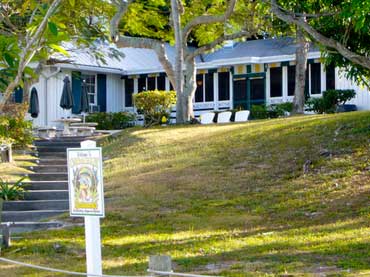
2. Cabbage Key in Pine Island Sound – just south of Charlotte Harbor, MM 22 on the G-ICW; marina overnight dockage is available with power and water; stop for lunch for a “Cheeseburger in Paradise.” Basin dockside carries 7′ water depths.
Pictured right.
3. Ft. Myers, FL – good touring opportunities; visit Thomas Edison’s Home and Laboratory; provision and re-fuel. The Great Loop divides at Ft. Myers into two alternative routes. Eastbound, from Ft. Myers Beach, you enter the Caloosahatchee River, transit the Okeechobee Waterway across the large man-made Lake Okeechobee, and emerge at Stuart, FL. The OWW traverses “working Florida” sugar cane and commercial farm country and some old – and not particularly prosperous – towns (Labelle, Clewiston, Moore Haven); very nice people, but not really tourist country. There are five Corps of Engineers locks (WP Franklin, Ortona, Moore Haven, Port Mayaca and St. Lucie) on route across the Okeechobee Waterway. With a Golden Age Passport, dockage at the W.P.Franklin Lock and the St. Lucie Lock, with electric and water, is $12 per night.
4. Southbound, from Ft. Myers Beach (toward Cape Sable, Florida Bay and the Florida Keys), deep draft vessels will want to go offshore from Ft. Myers Beach to the 10, 000 Islands Region south of the charted Cape Romano shoal. Boats less than 5′ draft may choose to go in at Gordon Pass, and proceed south on the charted and marked ICW-like channel. On that channel, there is a very nice, secluded anchorage in the mangroves at Rookery Bay; marinas are available at Marco Island; or, follow the channel south to Goodland. Immediately south of Marco Island, there is a high rise highway bridge across the channel. The red and green navigation markers reverse sides immediately East of that bridge. DO NOT MISS THE RED MARKER “26” TO THE SOUTH AND EAST OF THAT HIGHWAY BRIDGE! R”26″ is difficult to pick out against the shoreline, but honoring it is essential to avoid spoiling your day. In Goodland, there is a marina available; also, visit Stan’s Idle Hour for lunch or Happy Hour. The inside route from Goodland south through Coon Key Pass and into Gullivan Bay, east and inside of the Cape Romano shoal, carries 5′ at MLLW. South of Gullivan Bay deep draft boats can rejoin their shallower draft compatriots; the are excellent anchorages in this area at Panther Key and Indian Key.
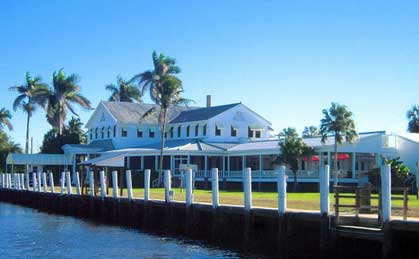
5. Everglades City, FL – stay at the Everglades City Rod and Gun Club, a/k/a “Sportsman’s Club.” They accept cash and personal checks, but do not accept credit cards. Go on walkabout in town; visit the small Everglades Museum; this is “Old Florida;” wonderful.
6. Little Shark River – superb, remote anchorage in the mangroves; no cell signal, no facilities; spend a couple of days and do some dinghy exploring; NO PLACE TO LAND PETS. Superb visibility of the night sky.
7. Marathon, FL – very popular “Florida Keys” location and lifestyle; there are several marinas that offer transient and long term dockage, and a large basin with mooring balls. Make reservations early. Rent a car here to visit Deer Key, Key West and the Dry Tortugas. “No Name Pub” on Deer Key is a great diner stop (Pizza is to die for)
8. Dry Tortugas National Park, Ft. Jefferson – recommend you do this by fast cat from Key West. The Dry Tortugas are a cluster of seven small islands 70 statute miles west of Key West in the Gulf of Mexico. There is no drinking water and no facilities at the Tortugas. Cruising boats are permitted to anchor, and can be caught offshore for long periods in prevailing SE winds or during passage of winter weather fronts.
9. Key West, FL – Margaritaville, of course. Many local and colorful attractions.
10. Key Largo, FL – Lorelai’s/Gilbert’s/Alabama Jack’s; Lorelai’s and Gilbert’s are overnight/dinner stops; both are very much worth while. Anchor off Lorelai’s and dinghy in. You can stay for free on the dock at Gilbert’s when stopping for dinner, or overnight for a fee. Alabama Jack’s is a hoot.
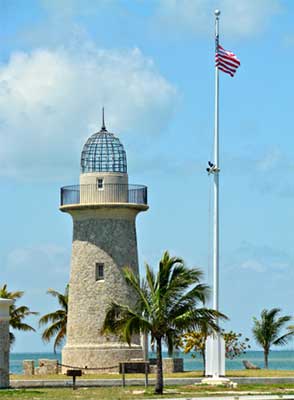
11. Boca Chita Key in Biscayne Bay, but definitely not on the weekend! The place is mobbed by locals on weekends. Do this weekdays only. Same with “No Name” Harbor at Key Biscayne.
12. “City people” like Miami/Ft. Lauderdale.
13. Ft. Pierce, FL – City Marina is a nice stop; nice tiki hut snack bar/bar; great Farmer’s Market on Saturday’s;
14. Indian Harbor Beach, FL – there are anchorages in the Banana River both above and below the Mathers Swing Bridge; the bridge operators are very cooperative. Also, Eau Gallie Yacht Club below the bridge, which is expensive but takes transients; make reservations 24 hrs in advance. There is a Publix Supermarket within walking distance, 1/2 – 3/4 miles south from the EGYC, for re-provisioning.
15. Titusville, FL – visit Cape Kennedy; There is a great seafood restaurant called “Dixie Crossroads” about a mile from the Titusville Municipal Marina.
16. St. Augustine, FL – must see; easy access from city run mooring field and city marina. Good city bus available; visit the Basilica Cathedral of St. Augustine and the Spanish fortress, the Castillo de San Marcos; alligator farm and St. Augustine Lighthouse Museum available by bus; A1A Ale House across from the city marina is excellent;
17. Fernandina Beach, FL – Good municipal marina and mooring field without launch service; very interesting historic town dates to 1560, predating Yorktown by 60 years. Visit and tour Billy Burbank’s Trawl Net factory, Civil War era Ft. Clinch on Amelia Island, and Pippi Longstocking’s house.
18. Jekyll Island, GA – Stay at marina and use courtesy car or bikes to visit Jekyll Island; see how the upper class lived at the turn of the 20th century.
19. Brunswick, GA – Good fuel stop on the East River at Ocean Petroleum; marinas for transient and long term stays, short walk to several good restaurants. Rent a car and visit St. Simons Island shoppes and lighthouse, and visit Ft. Frederica on St. Simons Island.
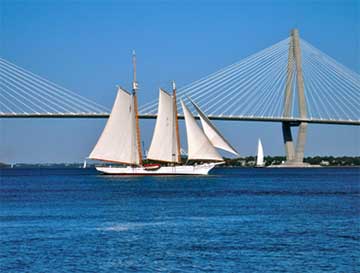
20. Savannah, GA – Jim likes the city docks, but Peg feels they are too public; the whole of the Savannah River is a “no wake” zone; large ship wakes will not bother you, but tugs still leave small but noticeable wakes. An alternative for dockage is to stay at Thunderbolt, GA, MM 583, or Isle of Hope, GA, MM 590, and catch a city bus into the Welcome Center in downtown Savannah. There is a live stage theater called the Savannah Theater that is a fun evening.
21. Beaufort, SC – BE VERY MINDFUL OF STRONG TIDAL CURRENTS IN THE BEAUFORT RIVER; excellent marina at Port Royal Landing; courtesy car for West Marina; OK municipal Marina without courtesy car, but with easy access to carriage ride of the magnificent antebellum mansions of the historic district.
22. Charleston, SC – To visit Charleston, we prefer the Charleston Maritime Center on the Cooper River to the City Marina, which is busy, tight, crowded and can be very tough in strong currents. It is also exposed to wakes from nearby Ashley River traffic that ignores the “no wake” zone as posted there. There is an anchorage across the river from the City Marina. St. John’s Harbour Marina is also very nice marina alternative; it’s immediately south of Charleston, on the Stono River 1/2 mile below Elliott’s Cut. Be very mindful of strong tidal currents in the Charleston area. Be sure to visit Ft. Sumter. There’s no dockage there for pleasure craft, but take the tour from the Ft. Sumter Visitor’s Center adjacent to the aquarium.
23. Manteo and Ocracoke, NC – on North Carolina’s Crystal Coast (Pamlico Sound); Manteo is the homeport of the Elizabeth II reproduction and the home of the Lost Colony Plantation. Ocracoke is a relaxing and historic island community. There is dockage at the Corps of Engineer’s dock at Silver Lake at Ocracoke, with power and water. Cost is minimal, and less with Golden Age Passport. Watch NC State ferries approaching and in Silver Lake.
24. Chesapeake Bay – Major stops include Norfolk/Portsmouth, the Historic Triangle (Yorktown/Jamestown/Williamsburg), Tangier Island, St. Mary’s City, Solomons, St. Michaels, Annapolis, Baltimore and Chesapeake City; also, of course, go up the Potomac to Mount Vernon, VA, and Washington, DC. There are dozens of great communities if you have the time to explore the Bay: Onancock, VA, Matthews, VA, Deltaville, VA, Reedville, VA, Smith Island, VA, Crisfield, MD, Cambridge, MD, Oxford, MD, Chestertown, MD, Salisbury, MD, Rock Hall, MD. And there are dozens of gunkholes if you prefer anchoring.
25. Philadelphia – a city, I know, but “off the beaten path,” so requires “honorable mention.” From the C&D Canal, divert upbound on the Delaware River to visit Philadelphia; the marina that’s been suggested to us is “Penn’s Landing.” Philadelphia is far enough from “the beaten path” that it’s not considered by many as a “cruising destination,” but it is a very historic locale, and has a most excellent Zoological Park. The Delaware Bay doesn’t offer much for cruisers, and there is really only one secure stop between the C&D Canal and Cape May, NJ, at the Cohansey River, in Greenwich, NJ. You can anchor in the Cohansey River or find dockage in Greenwich. The Delaware Bay is a large, open body of water which lies Northwest-Southeast. When NE-SW winds oppose ebb or flood currents in the bay, the seas become an uncomfortable, steep, short period, chop. This can be one of the nastier areas of the US east coast and the loop. Plan accordingly.
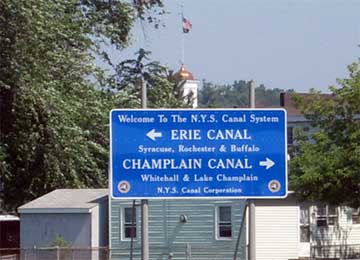
26. “City people” like New York
27. Kingston, NY – Well protected harbor in the Rondout Creek, on the west shore of the Hudson River; several marinas. This small city is the gateway city to the Catskill Mountains and nearby Woodstock (the 1969 Music Festival was at Bethel, NY); The CIA (Culinary Institute of America); West Point Military Academy (by car, two forms of picture id; no access by boat); small Maritime Museum and several good restaurants on the Rondout.
28. Waterford, NY – a very nice small town stop. There is a Visitor’s Center that offers free overnight dockage with electric. The free dockage space fills up early in the day during busy seasons. At Waterford, the NY State Canal System branches into two alternate routes; 1) north into Lake Champlain or 2) west into the Mohawk River of the Erie Canal. There are many wonderful villages and towns along the Mohawk. Loopers going west are advised to take the Oswego Canal at Three Rivers, and go to Oswego, NY. From Oswego, cross Lake Ontario to either visit the Thousand Island Region of NY, or cross directly to Kingston, Ontario. These crossings of eastern Lake Ontario are 30 to 35 StM. Weather can be a factor on Lake Ontario, so plan accordingly. There are safe harbors on both ends of either crossing route. Unless you’re fans of state capitols, Albany, NY, is just another aging state capitol. Loopers going north enter the Champlain Canal and pass Fort Edward and Fort Ticonderoga to reach Lake Champlain.
29. Whitehall, NY – Visit the small Skenesborough Museum. Learn more than you knew about Benedict Arnold. Consider renting a car to see Ft. Ticonderoga.
30. Vergennes, VT – The Otter Creek, water falls in town, very lovely and rustic;
31. Burlington, VT – Science museum, very nice pedestrian walk, several good restaurants;
32. Chambly, QC – 1749 era French fortress, re-enactors; Ft. Chambly
33. Montréal, QC – walk the Old Port City; visit Notre-Dame de Bon Secours chapel and the Science Center/Museum; take a boat ride on the Lachine Rapids. One strategy we recommend is that when we get to a large and new-to-us city, we take a tourist tour. That gives us a “lay-of-the-land” impression of what’s there, and helps us decide what we’d like to see more of while there.
34. Montebello, QC – Château Montebello; built in 90 days in 1930; positively amazing; superb.
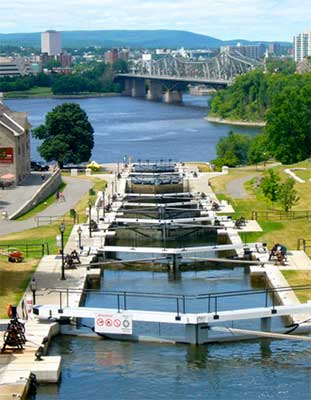
35. Ottawa, ON – Parliament, Changing-of-the-Guard, the Royal Canadian Mint, (no free samples, but cool), the Bytown Museum at the Flight-of-Eight Locks, a fine WWII Museum, a large and fun City Market; personally, we found Ottawa more welcoming and friendly than Montréal. One strategy we recommend is that when we get to a large and new-to-us city, we take a tourist tour. That gives us a “lay-of-the-land” impression of what’s there, and helps us decide what we’d like to see more of while there.
36. Kingston, ON – Kingston is a nice stop. Stay at Confederation Basin, downtown. They do not accept same day reservations, so call a day or two ahead. If you really want to hear some mumbo-jumbo, ask them why they don’t do same day reservations. It’s small amusement, but the chuckle value is worth it to us simple folk. Visit Ft. Henry, which overlooks the city and the St. Lawrence river.
37. The Royal Canadian Air Force Museum has a great WWII collection, including a vintage Halifax bomber; very cool place. It is located half way between Belleville, ON, and Trenton, ON. Stay at either community and rent a car.
38. Peterborough – the town is a nice, utilitarian place to re-provision. Jim liked the Peterborough Lift Lock; Peg did not.
39. Killarney, ON, and Little Current, ON – we preferred Little Current, but both are neat stops. Killarney is rustic.
40. Baie Fine – must see; Baie Fine is between Killarney and Little Current. For the boat, this is an anchorage. For the naturalist and hiker, this is a magnificent fjord-like cut in the Canadian Shield. There is a crystal clear mountain lake that is a fairly easy hike from the inner-most embayment, called “The Pool.” The Pool is foul with weeds, and shallow; the nearby approach is good anchorage field. The narrow cut is protected from foul weather except along the E- W axis of the cut.
41. Gore Bay, ON – nice small town; good place to re-provision and get some rest and recreation
42. Meldrum Bay, ON – very small, remote village; one restaurant; rustic, beautiful spot.
43. Drummond Island, MI – check in with US Customs and Immigration here;
44. Mackinac Island/St. Ignace, MI – Mackinac Island must have been some life in the 1870s; stage at one of these harbors for a weather window to transit the Straights of Mackinac and get to a safe harbor on Lake Michigan.
45. Beaver Island, MI – is north in Lake Michigan, and people report, it’s very nice.
46. Grand Haven, MI/South Haven, MI – Very nice little towns; Great Lakes Maritime Museum.
Note: We did not get to the Wisconsin-shore of Lake Michigan; we never had a weather window that was acceptable for crossing.
47. “City people” like Chicago
48. St. Joseph, MO/Alton, IL – rent a car for visiting St. Louis; the Gateway National Arch, the Cathedral Basilica of St. Louis, the National Great Rivers Museum at the Melvin Price Lock and Dam, Union Station, which has been converted into a city market type of place, the Anheuser-Busch Brewery to take their tour and enjoy free samples; at Alton, don’t miss Fast Eddie’s Eats.
49. Chattanooga and the Tennessee River – exquisite, especially in the fall; Chattanooga Battlefield, Lookout Mountain via Incline Railroad; Chickamauga Battlefield; the Chattanooga Choo Choo.
50. Shiloh, TN – Shiloh Battlefield; if you really want to understand the Civil War, you must visit here.
51. Savannah, TN – Tennessee Williams’ Home; the Tennessee River Museum
52. Huntsville, AL – Air and Space Museum, Constitution Square; Burritt’s-On-The-Mountain.
53. Columbus, MS – don’t miss the experience of a dinner at Profitt’s Porch.
54. Mobile, AL – there’s a lot to see and do; rent a car and visit New Orleans; also a great place to change oil, filters, etc., for the boat. And, If the weather blows up, Mobile Bay can be a really lousy ride!
55. Carrabelle, FL – MUST await weather window to cross the gulf (or add a couple of travel days to go “the long way” around the Great Bend; i.e., from Carrabelle to maybe St. Marks, Steinhatchee, Cedar Key. Refer to Skipper Bob for ideas. The crossing from Carrabelle to Tarpon Springs City Marina is 171.1 StM. We ran it overnight. We left Carrabelle at 14h00 and arrived at the Tarpon Springs City Marina the following day at noon. If going the long way ’round, you will still need multiple weather windows, as those town-to-town transits are each very exposed. Further, if the wind blows from the northwest through northeast, it can blow water out of shallow entry channels in the Great Bend towns, and you may have to wait to get out again.
56. Tarpon Springs, FL – predominantly Greek-heritage community; superb Greek food; sponge fishing museum; great stop to take a day or two to “recover” from long cross-gulf run, especially if it was a “lumpy” crossing.
57. Sarasota, FL – excellent stop; there are marinas and a mooring field available; see the John Ringling Home and Circus Museum; symphony orchestra; airport and Amtrak available; superb rest and recreation stop.
Note 1: The control depth of the Rideau Canal is 6 ft. The control depth of the Trent-Severn Waterway is 5 ft. Parcs Canada will have you sign a liability waiver if you draw more than 5 ft. or 4 ft. respectively. There’s no slack in those measurements. The control depth on both canals is determined by the lock sills, not natural bottom features or obstructions. As a statement of boat draft, if you can make these locks, you can make the entire trip. STAY INSIDE THE MARKERS ON BOTH CANALS!
Note 2: Several of the locks on the Rideau Canal have water levels that are within 6″ of the deck elevation of lock copings. In these locks, fenders will roll out from between the coping and the boat. When the chamber is full, there is not enough space for fenders to occupy in order to hold the boat away from the coping. In these situations, especially when crosswinds pushed the boat into the wall, I actually jumped off the boat to hold it off the wall until the water level changed enough for the fenders to do their job.
Note 3: Columbus, MS, to Mobile, AL – 5 travel days (depart Columbus, stop at Tombigbee River anchorage, Demopolis Yacht Basin, Bashi Creek anchorage, Three Rivers anchorage, arrive Dog River marina) Limited places to overnight in this stretch. Refer to Skipper Bob’s books for locations. Some long days. In the late fall, you have fewer hours of daylight available for travel.
Note 4: Mobile, AL, to Carrabelle, FL – 5 travel days (depart Mobile, stop at Pensacola Yacht Club, Ft. Walton Yacht Club, Panama City Marina, Water Street Hotel Marina at Apalachicola, C-Quarters Marina)
Note 5: Carrabelle to Ft. Myers – 5 travel days (depart Carrabelle, stop at Tarpon Springs City Marina, Bradenton Yacht Club, Moore’s Stone Crab Restaurant (free overnight if you eat there) on Longboat Key, Cayo Costa State Park (Pelican Bay) anchorage, Ft. Myers Beach/Ft. Myers downtown).
If you have follow-on plane or commercial travel plans at this point, you may want to wait until you get to Tarpon Springs to make or confirm reservations. That way, you’re past all of the offshore, exposed, open water runs that can create weather delays. (remember the Prime Directive: The most dangerous thing you can have aboard a boat is a schedule!) From Tarpon Springs to Ft. Myers, you’ll be running in mostly protected ICW conditions, (except Tampa Bay) and you’ll be OK to travel on inland waters even when you (could not)/(would not want to) travel offshore in the Gulf.
By Jim Healy from his Blog Travels of the Monk 36 Trawler, Sanctuary
Disclaimer: Curtis Stokes and Associates does not necessarily agree or promote the content by the above author. This content is to be used only with the reader’s discretion.
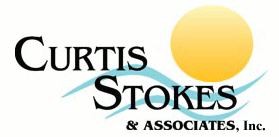
© 2024 Curtis Stokes & Associates, Inc. | All rights reserved.